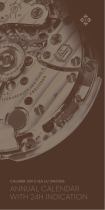Patek Philippe 5116 Guía del usuario
- Categoría
- Relojes
- Tipo
- Guía del usuario

MANUALLY WOUND MOVEMENTS
MANUALLYWOUND
MOVEMENTS
CALIBERS 215, 215 PS, 215 PS LU, 25-21 REC

English ........................ 3
Français ..................... 23
Deutsch ..................... 43
Italiano ....................... 63
Español ...................... 83
.....................103
.................. 123
................. 143
CALIBERS
PS
PSLU REC
MANUALLY WOUND MOVEMENTS

English
CALIBERS
PS
PSLU REC
MANUALLY WOUND MOVEMENTS
English

5
Remaining faithful to the spirit of the art of fine
watchmaking, Patek Philippe has always attached a
great deal of importance to the quality of its move-
ments. The brand is part of a small circle of authentic
manufacturers who all develop and manufacture
their own calibers. A demanding process that com-
bines ancestral savoir-faire with avant-garde design,
manual expertise, and cutting-edge technology.
Patek Philippe manual winding movements reflect
one of the key principles of watch manufacturing:
integrating maximum complexity into minimum
dimensions to create a case that is exceptionally slim
and timelessly elegant. The epitome of fine horolog-
ical construction, Patek Philippe’s movements are
also distinguished by their refined finishes.

76
DISPLAYS
Hour hand
Minute hand
CROWN
1 Manual winding
2 Setting the time
MOVEMENT
• Caliber 215
• Manual winding
• Diameter: 21.90 mm
• Height: 2.55 mm
• Number of parts: 130
• Number of jewels: 18
• Power reserve:
min. 44 hours
• Balance: Gyromax®
• Frequency:
28,800 semi-oscillations/hour (4 Hz)
• Balance spring: Spiromax®
• Patek Philippe Seal

98
DISPLAYS
Hour hand
Minute hand
Subsidiary dial:
Small seconds
CROWN
1 Manual winding
2 Setting the time
MOVEMENT
• Caliber 215 PS
• Manual winding
• Diameter: 21.90 mm
• Height: 2.55 mm
• Number of parts: 130
• Number of jewels: 18
• Power reserve:
min. 44 hours
• Balance: Gyromax®
• Frequency:
28,800 semi-oscillations/hour (4 Hz)
• Balance spring: Spiromax®
• Patek Philippe Seal

1110
DISPLAYS
Hour hand
Minute hand
Subsidiary dial:
Small seconds
Aperture:
Moon phases
CROWN
1 Manual winding
2 Setting the time
CORRECTION
PUSHPIECE
Moon-phase correction
MOVEMENT
• Caliber 215 PS LU
• Manual winding
• Diameter: 21.90 mm
• Height: 3 mm
• Number of parts: 157
• Number of jewels: 18
• Power reserve:
min. 39 hours – max. 44 hours
• Balance: Gyromax®
• Frequency:
28,800 semi-oscillations/hour (4 Hz)
• Balance spring: Spiromax®
• Patek Philippe Seal

1312
DISPLAYS
Hour hand
Minute hand
CROWN
1 Manual winding
2 Setting the time
MOVEMENT
• Caliber 25-51 REC
• Manual winding
• Dimensions: 25 x 21.90 mm
• Height: 2.57 mm
• Number of parts: 142
• Number of jewels: 18
• Power reserve:
min. 44 hours
• Balance: Gyromax®
• Frequency:
28,800 semi-oscillations/hour (4 Hz)
• Balance spring: Spiromax®
• Patek Philippe Seal

INSTRUCTIONS
14 15
SETTINGTHETIME
To set the time, gently pull the crown all the way
out and move the hands in either direction. Once
you have set the correct time, push the crown home
again.
WINDINGCROWN
The winding crown is used to manually wind the
watch (position 1) and to set the time (position 2).
WINDING
Your watch incorporates a manually wound move-
ment. Fully wound, it will continue to run for at
least:
- 44 hours if your watch is equipped with calibers
215, 215 PS, and 25-21 REC
- 39 hours if your watch is equipped with the caliber
215 PS LU
We recommend that you wind your watch at about
the same time every day, preferably in the morning.
Turn the crown clockwise gently and steadily, and
stop when you feel resistance. Excessively forceful
winding could damage the movement.

1716
MOONPHASECORRECTION
Each time the correction push piece at 6 o’clock
(Ref. 4968) or at 8 o’clock (Ref. 7121) is actuated,
the moon-phase disk will advance by one day.
To begin the correction procedure, advance the
moon-phase disk until a full moon is displayed in
the middle of the aperture. Consult an almanac or
visit www.patek.com and count the number of days
that have elapsed since the last full moon (relative
to the current date). To set the correct moon phase,
press the correction push piece as many times as
the number of days that have elapsed since the last
full moon.
Please wind the watch and set the time before
y
ou put the watch on. This prevents lateral
pressure on the winding stem. Please use
your fingernails to pull the crown out and
turn it gently between two fingertips.
Never pull out the crown in a humid envi-
ronment or underwater: the water resist-
ance of your watch is assured only when
the crown is pushed home.
The correction push piece should be actu-
ated exclusively with the correction stylus
that was delivered with the watch. The use
of any other tool could damage your time-
piece.
If your watch has stopped running, rewind
it fully before performing any corrections or
adjustments.
Do not perform any moon-phase correction
between 4 p.m. and 8 p.m. or between 4 a.m.
and 8 p.m.
CAUTION

MAINTENANCE
18 19
QUALITYCONTROL
The movements and completely assembled watches
are subject to a series of technical tests and visual
inspections to verify their rate accuracy, winding
speed, power reserve, reliability, water resistance,
and overall appearance. Once assembled, your man-
ually wound watch will run for several weeks before
leaving the workshops; it fully complies with the
stringent criteria of the Patek Philippe Seal.
ACCURACY
The rate accuracy of Patek Philippe watches is ver-
ified in several phases of manufacturing, both with
uncased and fully cased movements. The final test
is performed with a wrist motion simulator and
the results must conform to the following Patek
Philippe precision benchmarks:
The rate accuracy of calibers with a diameter of 20 mm
or larger must range within -3 and +2 seconds per
24 hours.
The precision of a watch is determined by how accu-
rately it keeps the time. A watch that is fast or slow
is considered precise if the amount by which it is
fast or slow remains constant. Such a deviation can
be easily corrected. Consequently, the final test of
accuracy takes place on your wrist. Your tempera-
ment or the nature of your physical activities can
cause slight irregularities. Fluctuations in position,
temperature, or air pressure, the presence of mag-
netic fields (as produced by most electronic devices,
metal detectors, household appliances, etc.) as well
as vibrations and other factors may also affect its
accuracy. If you notice that your watch exhibits
CERTIFICATEOFORIGIN
Your watch is delivered with a certificate of origin
that indicates the movement and case numbers. The
certificate is valid only if it is dated, signed by an
Authorized Patek Philippe Retailer, and completed
with your name. It guarantees the authenticity of
your watch and validates your warranty privileges
for a period of two years after the date of sale. The
unique movement and case numbers of each watch
are transcribed into the workshop journals. With
this information, you may have yourself entered
in the Patek Philippe Register of Owners and will
obtain the International Patek Philippe Magazine free
of charge.
PATEKPHILIPPESEAL
As an all-encompassing hallmark of quality,
the Patek Philippe Seal applies to the entire
watch, including the movement, case, dial,
hands, pushers, strap, and clasp as well as to all other
facets that contribute to the precision and aesthetic
perfection of the timepiece. It covers the technical,
functional, and aesthetic factors, but also rate accu-
racy, dependability, and customer service quality.
Additionally, it reflects the maker’s know-how and
all other assets needed for the development, produc-
tion, and long-term maintenance of an extraordinary
timekeeping instrument.

2120
The watchmaker will completely disassemble the
movement and then inspect, clean, and lubricate
all of the individual parts prior to reassembly. All
functions of the watch will also be tested in detail
and the escapement regulated if necessary. Finally,
its rate accuracy will be monitored and precision-
adjusted for a further period of two weeks. The
entire process may take several weeks because each
watch must undergo a complete series of tests to
fulfill the strict quality criteria of Patek Philippe.
If you have any questions regarding the maintenance
of your watch or need the address of your closest
Authorized Patek Philippe Service Center, contact our
International Customer Service Department in Geneva,
or visit www.patek.com.
such irregularities, please do not hesitate to take
it to an Authorized Patek Philippe Retailer or an
Authorized Service Center where no effort will be
spared to assure that it is adjusted to meet your
expectations.
WATERRESISTANCE
Your watch is fitted with different types of seals
to protect the movement against the ingress of
dust and moisture and to prevent damage if it is
immersed in water. Nonetheless, we recommend
that you prevent direct contact with water if your
watch has a leather strap.
It is advisable to have a water-resistance test car-
ried out every year on your watch. This is a simple
procedure that takes only a few minutes at a prop-
erly equipped point of sale.
SERVICE
We recommend that you have your watch serviced
every three to five years. With this in mind, we
suggest that you take or send your watch to an
Authorized Patek Philippe Retailer or an Author-
ized Service Center. This gives you the assurance
that your watch will be entrusted to the hands of
a qualified Patek Philippe watchmaker in Geneva
or at an Authorized Service Center.

Français
CALIBRES
PS
PSLU REC
MOUVEMENTS MANUELS
Français

25
Fidèle à l’esprit du grand art horloger, Patek
Philippe a toujours accordé une importance majeure
à l’excellence de ses mouvements. La maison
s’inscrit dans le cercle restreint des authentiques
manufactures à même de développer et fabriquer
leurs propres calibres. Une démarche exigeante où
s’allient savoir-faire ancestral et recherche d’avant-
garde, compétences manuelles et technologies de
pointe. Les mouvements Patek Philippe à remon-
tage manuel reflètent l’un des grands principes de
la manufacture : loger un maximum de complexité
dans un minimum d’espace et de diamètre afin de
donner au boîtier une minceur optimale, gage
d’élégance intemporelle. Fleurons de construction
horlogère, ils se distinguent aussi par le raffinement
de leurs finitions.

2726
INDICATIONS
Aiguille des heures
Aiguille des minutes
COURONNE
1 Remontage manuel
2 Mise à l’heure
MOUVEMENT
• Calibre 215
• Remontage manuel
• Diamètre : 21,90 mm
• Épaisseur : 2,55 mm
• Nombre de composants : 130
• Nombre de rubis : 18
• Réserve de marche :
min. 44 heures
• Balancier : Gyromax®
• Fréquence :
28 800 alternances/heure (4 Hz)
• Spiral : Spiromax®
• Poinçon Patek Philippe

2928
INDICATIONS
Aiguille des heures
Aiguille des minutes
Cadran auxiliaire :
Petite seconde
COURONNE
1 Remontage manuel
2 Mise à l’heure
MOUVEMENT
• Calibre 215 PS
• Remontage manuel
• Diamètre : 21,90 mm
• Épaisseur : 2,55 mm
• Nombre de composants : 130
• Nombre de rubis : 18
• Réserve de marche :
min. 44 heures
• Balancier : Gyromax®
• Fréquence :
28 800 alternances/heure (4 Hz)
• Spiral : Spiromax®
• Poinçon Patek Philippe

3130
INDICATIONS
Aiguille des heures
Aiguille des minutes
Cadran auxiliaire :
Petite seconde
Guichet :
Phases de lune
COURONNE
1 Remontage manuel
2 Mise à l’heure
BOUTON
CORRECTEUR
Correction des phases de lune
MOUVEMENT
• Calibre 215 PS LU
• Remontage manuel
• Diamètre : 21,90 mm
• Épaisseur : 3 mm
• Nombre de composants : 157
• Nombre de rubis : 18
• Réserve de marche :
min. 39 heures – max. 44 heures
• Balancier : Gyromax®
• Fréquence :
28 800 alternances/heure (4 Hz)
• Spiral : Spiromax®
• Poinçon Patek Philippe

3332
INDICATIONS
Aiguille des heures
Aiguille des minutes
COURONNE
1 Remontage manuel
2 Mise à l’heure
MOUVEMENT
• Calibre 25-51 REC
• Remontage manuel
• Dimensions : 25 x 21,90 mm
• Épaisseur : 2,57 mm
• Nombre de composants : 142
• Nombre de rubis : 18
• Réserve de marche :
min. 44 heures
• Balancier : Gyromax®
• Fréquence :
28 800 alternances/heure (4 Hz)
• Spiral : Spiromax®
• Poinçon Patek Philippe

MODE D’EMPLOI
34 35
MISEÀL’HEURE
L’heure se règle en tirant doucement la couronne
et en déplaçant les aiguilles vers l’avant ou vers
l’arrière. Une fois l’heure ajustée, n’oubliez pas de
repousser la couronne contre le boîtier.
COURONNE
DEREMONTOIR
Le remontage manuel (position 1) et la mise à l’heure
(position 2) s’effectuent à l’aide de la couronne de
remontoir.
REMONTAGE
Votre montre est dotée d’un mouvement à remon-
tage manuel. Complètement remontée, elle bénéficie
d’une réserve de marche de minimum :
- 44 heures pour les montres équipées des calibres
215, 215 PS et 25-21 REC
- 39 heures pour les montres équipées du calibre
215 PS LU
Nous vous recommandons de remonter votre montre
chaque jour à la même heure, de préférence le matin.
Tournez doucement la couronne, dans le sens des
aiguilles d’une montre, et arrêtez dès que vous sen-
tez une résistance ; un remontage trop énergique
peut endommager le mouvement.

3736
CORRECTION
DESPHASESDELUNE
À chaque pression sur le bouton correcteur situé à
6 h (Référence 4968) ou à 8 heures (Référence 7121),
le disque de la lune progresse d’un jour vers une
nouvelle phase. Commencez par faire avancer le
disque lunaire jusqu’à ce que la lune apparaisse au
centre du guichet sous sa forme pleine. Consultez
ensuite un almanach ou le site www.patek.com pour
déterminer le nombre de jours écoulés depuis la der-
nière pleine lune (y compris le jour du réglage). Pour
positionner la lune sur sa phase exacte, pressez sur
le bouton correcteur autant de fois qu’il y a de jours
écoulés depuis la dernière pleine lune.
Il est préférable d’effectuer le remontage
et la mise à l’heure hors du poignet afin
d’éviter les pressions latérales sur le tube
de la couronne. Nous vous recommandons
de n’utiliser que deux doigts et de faire levier
avec l’ongle pour tirer la couronne.
Ne tirez jamais la couronne dans un environ-
nement humide ou dans l’eau. L’étanchéité
de votre montre n’est garantie qu’avec la
couronne poussée contre le boîtier.
Pour actionner le bouton correcteur, uti-
lisez exclusivement le crayon de fonction
fourni avec la montre. Tout autre outil risque
d’endommager votre garde-temps.
Si votre montre s’est arrêtée, il est impéra-
tif d’effectuer un remontage complet avant
toute correction ou manipulation.
Aucun réglage des phases de lune ne doit
être
effectué entre 16 h et 20 h et entre 4 h et
8 h du matin.
IMPORTANT

ENTRETIEN
38 39
CONTRÔLES
Les mouvements et les montres finies sont soumis à
une série de tests techniques et esthétiques portant
notamment sur la précision, la vitesse de remon-
tage, la réserve de marche, la fiabilité, l’étanchéité
et l’aspect extérieur. Votre montre à remontage
manuel, une fois assemblée, a fonctionné plusieurs
semaines avant de quitter la manufacture et elle
remplit parfaitement les exigences ultrarigoureuses
du Poinçon Patek Philippe.
PRÉCISION
La précision de marche des montres Patek Philippe
est contrôlée à plusieurs étapes de la production, sur
les mouvements seuls, puis emboîtés. Le contrôle
final se déroule sur un simulateur de porter et il doit
répondre aux normes de précision Patek Philippe
suivantes :
Pour les calibres dont le diamètre est supérieur ou égal
à 20 mm, la précision de marche doit être comprise dans
la plage de [-3; +2] s/24 h.
La précision d’une montre se mesure à sa régula-
rité. Un mouvement qui avance ou retarde est exact
si cette avance ou ce retard journalier est constant.
Cet écart peut être aisément corrigé. Le dernier
test que devra subir votre montre sera celui de son
fonctionnement à votre poignet. Les variations de
position, de température ou de pression, les champs
magnétiques (tels que ceux générés par la plupart
des équipements électroniques, portiques de sécu-
rité ou appareils électroménagers), les vibrations et
bien d’autres facteurs peuvent affecter la précision. Si
vous deviez constater un tel dérèglement, n’hésitez
CERTIFICATD’ORIGINE
Votre montre Patek Philippe est accompagnée d’un
certificat d’origine mentionnant notamment ses
numéros de mouvement et de boîtier. Ce document
doit être dûment daté et signé par le détaillant agréé
Patek Philippe et obligatoirement complété à votre
nom. Il atteste l’authenticité de votre garde-temps
et fait office de garantie internationale, valable deux
ans à partir de la date d’achat. Les numéros indivi-
duels de boîtier et de mouvement de chaque montre
sont archivés dans les livres d’établissement de la
manufacture. En indiquant ces informations, vous
pouvez vous inscrire dans le « registre des proprié-
taires » Patek Philippe afin de recevoir à titre gra-
cieux le Magazine International Patek Philippe.
POINÇONPATEKPHILIPPE
Label de qualité globale, le Poinçon Patek
Philippe s’applique à l’ensemble de la montre
finie, en incluant le mouvement, le boîtier,
le cadran, les aiguilles, les poussoirs, les bracelets
et les fermoirs, ainsi que tous les autres éléments
concourant à la bonne marche ou à la perfection
extérieure d’un garde-temps. Couvrant à la fois les
aspects techniques, fonctionnels et esthétiques, il
ne met pas seulement en valeur la bienfacture de la
montre, mais aussi sa précision et sa fiabilité, ainsi
que la qualité du service. Il intègre par là même tous
les savoir-faire et signes distinctifs liés à la concep-
tion, à la fabrication et à l’entretien à long terme d’un
garde-temps d’exception.

4140
L’horloger démontera complètement le mouvement,
nettoiera tous ses composants, le vérifiera et le lubri-
fiera lors du remontage. Après avoir testé son bon
fonctionnement et procédé, si nécessaire, au réglage
de l’échappement, il gardera encore la montre deux
semaines supplémentaires afin de régler la marche.
L’ensemble du service peut prendre plusieurs
semaines – le temps nécessaire pour réaliser tous
les tests et contrôles permettant de répondre aux
normes de qualité Patek Philippe.
Pour toute question concernant l’entretien de votre
montre, ou pour obtenir l’adresse du centre de service
agréé Patek Philippe le plus proche, veuillez contacter
notre Service Client International, à Genève, ou consul-
ter notre site Internet www.patek.com.
pas à déposer votre montre chez un détaillant agréé
Patek Philippe ou dans un centre de service agréé,
qui prendra les mesures nécessaires pour régler
votre garde-temps selon vos exigences.
ÉTANCHÉITÉ
Votre montre est dotée de joints et de fermetures
conçus pour protéger le mouvement de la poussière,
de l’humidité et de tout risque de détérioration en
cas d’immersion. Nous vous suggérons toutefois
d’éviter qu’elle n’entre en contact avec l’eau si elle
est munie d’un bracelet en cuir.
Il est recommandé de faire effectuer un test d’étan-
chéité sur votre montre chaque année. Cette pro-
cédure simple ne prend que quelques minutes dans
un point de vente équipé à cet effet.
RÉVISION
Nous vous recommandons de faire réviser votre
montre au moins une fois tous les trois à cinq ans.
Il vous suffit pour cela de la remettre (éventuel-
lement de l’envoyer) à un détaillant ou un centre
de service agréé Patek Philippe. Vous aurez ainsi
l’assurance qu’elle sera confiée à un horloger qua-
lifié Patek Philippe, à Genève ou dans un centre
de service agréé à travers le monde.

Deutsch
KALIBER
PS
PSLU REC
UHRWERKE MIT HANDAUFZUG
Deutsch

45
Ganz im Sinne der Haute Horlogerie hat Patek
Philippe der Spitzenqualität ihrer Uhrwerke schon
immer große Bedeutung beigemessen. Das Genfer
Haus gehört zu jenem erlauchten Kreis authenti-
scher Manufakturen, die heute noch ihre eigenen
Kaliber herstellen können. Überliefertes Savoir-
faire und modernste Forschung, Hand geschick und
Spitzentechnologien verschmelzen hier zu Verfah-
ren, die höchste Ansprüche erfüllen. Die Uhrwerke
mit Handaufzug von Patek Philippe sind Ausdruck
eines ehernen Grundsatzes der Manufaktur: maxi-
male Komplexität auf minimalem Raum. So wirkt
das Gehäuse stets wunderbar schlank und zeitlos
elegant. Dass es sich hier um Meisterwerke der
Uhrmacherkunst handelt, bekunden auch die raf-
finierten Finissierungen.

4746
ANZEIGEN
Stundenzeiger
Minutenzeiger
KRONE
1 Handaufzug
2 Einstellen der Uhrzeit
UHRWERK
• Kaliber 215
• Handaufzug
• Durchmesser: 21,90mm
• Höhe: 2,55mm
• Anzahl der Einzelteile: 130
• Anzahl der Rubine: 18
• Gangreserve:
min. 44 Stunden
• Unruh: Gyromax®
• Frequenz:
28 800 Halbschwingungen/Stunde
(4Hz)
• Spirale: Spiromax®
• Patek PhilippeSiegel

4948
ANZEIGEN
Stundenzeiger
Minutenzeiger
Hilfszifferblatt:
Kleine Sekunde
KRONE
1 Handaufzug
2 Einstellen der Uhrzeit
UHRWERK
• Kaliber 215 PS
• Handaufzug
• Durchmesser: 21,90mm
• Höhe: 2,55mm
• Anzahl der Einzelteile: 130
• Anzahl der Rubine: 18
• Gangreserve:
min. 44 Stunden
• Unruh: Gyromax®
• Frequenz:
28 800 Halbschwingungen/Stunde
(4Hz)
• Spirale: Spiromax®
• Patek PhilippeSiegel

5150
ANZEIGEN
Stundenzeiger
Minutenzeiger
Hilfszifferblatt:
Kleine Sekunde
Fenster:
Mondphasen
KRONE
1 Handaufzug
2 Einstellen der Uhrzeit
KORREKTUR-
DRÜCKER
Mondphasenkorrektur
UHRWERK
• Kaliber 215 PS LU
• Handaufzug
• Durchmesser: 21,90mm
• Höhe: 3mm
• Anzahl der Einzelteile: 157
• Anzahl der Rubine: 18
• Gangreserve:
min. 39 Stunden – max. 44 Stunden
• Unruh: Gyromax®
• Frequenz:
28 800 Halbschwingungen/Stunde
(4Hz)
• Spirale: Spiromax®
• Patek PhilippeSiegel

5352
ANZEIGEN
Stundenzeiger
Minutenzeiger
KRONE
1 Handaufzug
2 Einstellen der Uhrzeit
UHRWERK
• Kaliber 25-51 REC
• Handaufzug
• Abmessungen: 25 × 21,90mm
• Höhe: 2,57mm
• Anzahl der Einzelteile: 142
• Anzahl der Rubine: 18
• Gangreserve:
min. 44 Stunden
• Unruh: Gyromax®
• Frequenz:
28 800 Halbschwingungen/Stunde
(4Hz)
• Spirale: Spiromax®
• Patek PhilippeSiegel

BEDIENUNGSANLEITUNG
54 55
EINSTELLENDERUHRZEIT
Um die Zeiger auf die richtige Uhrzeit zu stellen,
ziehen Sie die Aufzugskrone und drehen diese vor-
oder rückwärts. Drücken Sie die Krone wieder an
das Gehäuse, sobald Sie die Uhrzeit eingestellt
AUFZUGSKRONE
Das manuelle Aufziehen (Position 1) und das Ein-
stellen der Uhrzeit (Position 2) erfolgen mit Hilfe
der Aufzugskrone.
AUFZIEHEN
Ihre Uhr besitzt ein Uhrwerk mit Handaufzug.
Wenn die Uhr vollständig aufgezogen ist, verfügt
sie über eine Gangreserve von mindestens:
- 44 Stunden bei Uhren mit den Kalibern 215,
215 PS und 25-21 REC
- 39 Stunden bei Uhren mit dem Kaliber 215 PS LU
Wir empfehlen Ihnen, Ihre Uhr jeden Tag zu der-
selben Uhrzeit aufzuziehen, am besten morgens.
Drehen Sie die Krone sorgfältig im Uhrzeigersinn
und hören Sie auf, sobald Sie einen Widerstand
spüren. Ein zu kraftvolles Aufziehen könnte das
Uhrwerk beschädigen.

5756
MONDPHASENKORREKTUR
Durch jedes Betätigen des Korrekturdrückers
bei 6 Uhr (Referenz 4968) oder bei 8 Uhr (Refe-
renz 7121) dreht sich die Scheibe um einen Tag
zu einer neuen Mondphase. Um die Einstellung zu
beginnen, rücken Sie die Mondscheibe so weit vor,
bis in der Mitte des Fensters der Vollmond ange-
zeigt wird. Schlagen Sie in einer Agenda oder unter
www.patek.com nach und zählen Sie, wie viele Tage
seit dem letzten Vollmond vergangen sind (in Bezug
auf das eingestellte Datum). Betätigen Sie jetzt zum
Einstellen der korrekten Mondphasenanzeige den
Korrekturdrücker entsprechend der Anzahl Tage
seit dem letzten Vollmond.
Nehmen Sie die Uhr zum Aufziehen und
Einstellen der Uhrzeit vom Handgelenk. Sie
vermeiden dadurch seitlichen Druck auf
das Aufzugsrohr. Benutzen Sie zum Ziehen
der Krone die Fingernägel und drehen Sie
die Krone zwischen zwei Finger spitzen.
Ziehen Sie die Krone keinesfalls in feuchter
Umgebung oder im Wasser. Die Wasser-
dichtheit Ihrer Uhr ist nur bei gegen das
Gehäuse ge drückter Krone gewährleistet.
Die Korrekturdrücker sollten aus schließ-
lich mit dem Korrekturstift betätigt wer den,
der mit der Uhr geliefert wurde. Jedes
andere Werkzeug könnte Ihren Zeit messer
beschädigen.
Falls Ihre Uhr stehen geblieben ist, muss
sie mit der Aufzugskrone vollständig auf-
ge zogen werden, bevor irgendwelche
Kor rekturen oder andere Einstellungen
vor genommen werden.
Die Mondphasenanzeige darf zwischen
16 und 20 Uhr und zwischen 4 und 8 Uhr
morgens nicht korrigiert werden.
WICHTIG

WARTUNG
58 59
KONTROLLEN
Jedes Uhrwerk und jede Uhr werden einer Reihe
technischer und visueller Kontrollen unterzo-
gen, bei denen insbesondere Ganggenauigkeit,
Aufzugsgeschwindigkeit, Gangreserve, Zuver-
lässigkeit, Wasserdichtheit und äußeren Aspekte
geprüft werden. Ihre Uhr mit Handaufzug ist
nach der Fertigstellung bereits mehrere Wochen
gelaufen, bevor sie die Manufaktur verlässt. Sie
erfüllt nun die strengen Anforderungen des Patek
Philippe Siegels.
GANGGENAUIGKEIT
Die Ganggenauigkeit der Patek Philippe Uhren
wird bei unterschiedlichen Produktionsschritten,
bei den Uhr
werken allein sowie fertig ins Gehäuse
eingeschalt, geprüft. Die Endkontrolle erfolgt am
Tragsimulator und muss folgende Patek Philippe
Präzisionsvorgaben erfüllen:
Für Kaliber mit einem Durchmesser von 20 mm oder
größer muss sich die Ganggenauigkeit im Bereich von
[-3; +2] Sekunden/24 Stunden bewegen.
Die Präzision einer Uhr zeigt sich am regelmäßi-
gen Gang. Ein Uhrwerk, das vor- oder nachgeht, ist
genau, wenn dieser tägliche Vor- oder Nachgang kon-
stant gleich ausfällt. Eine solche Abweichung kann
auf einfache Weise korrigiert werden. Der letzte Test
Ihrer Uhr erfolgt an Ihrem Handgelenk. Änderun-
gen der Lage, der Temperatur oder des Luftdrucks
sowie Einflüsse von Magnetfeldern (wie sie von den
meisten Elektronikgeräten, Sicherheits
schleusen,
Haushaltsgeräten u. ä. erzeugt werden),
Vibrati-
onen und weitere Faktoren können die
Präzision
URSPRUNGSZERTIFIKAT
Ihre Uhr wird mit einem Ursprungszertifikat aus-
geliefert, in dem die Werk- und Gehäuse nummern
vermerkt sind. Es muss unbedingt datiert, durch
die offizielle Patek Philippe Verkaufsstelle sig-
niert und auf Ihren Namen ausgestellt sein. Es
garantiert die Echtheit der Uhr und dient als
Garantie schein für die Dauer von zwei Jahren ab
Kaufdatum. Die individuellen Werk- und Gehäuse-
nummern jeder Uhr werden in den Archivbüchern
der Manufaktur vermerkt. Mit diesen Informatio-
nen können Sie sich im „Register der Besitzer von
Patek Philippe Uhren“ eintragen lassen, damit Sie
kostenlos das Internationale Patek Philippe Magazin
erhalten.
PATEKPHILIPPESIEGEL
Das Patek Philippe Siegel gilt als um fas-
sendes Gütezeichen für die Uhr in ihrer
Gesamtheit, also inklusive Uhrwerk,
Gehäuse, Zifferblatt, Zeiger, Drücker, Armband
und Schließe, sowie aller anderen Merkmale, die
zum guten Gang und zur ästhetischen Perfektion
des Zeitmessers beitragen. Es gilt für die techni-
schen, funktionalen und ästhetischen Aspekte, aber
auch für die Gang genauigkeit und Zuverlässigkeit
sowie die Qualität des Kundendienstes. Er gilt
zudem für das ganze Savoir-faire und alle Beson-
derheiten, die für die Entwicklung, die Fertigung
und die langfristige Wartung dieses außergewöhn-
lichen Zeitmessers erforderlich sind.

6160
Der Uhrmacher wird das Uhrwerk vollständig zer-
legen, alle Einzelteile reinigen, prüfen und sie beim
Wiederzusammensetzen ölen. Nach der eingehen-
den Prüfung aller Funktionen und einer eventuellen
Regulierung der Hemmung kümmert er sich noch
zwei Wochen lang um die Feinregulierung der
Gang genauigkeit Ihrer Uhr. Die ganze Revision
kann mehrere Wochen dauern, weil jede Uhr alle
Testreihen durchlaufen muss, um die hohen Quali-
tätsvorgaben von Patek Philippe zu erfüllen.
Wenden Sie sich für alle Fragen bezüglich der Wartung
Ihrer Uhr und für die Adresse des nächsten autorisierten
Patek Philippe Service-Centers an unseren internatio-
nalen Kundendienst in Genf, oder besuchen Sie unsere
Website im Internet unter www.patek.com.
beeinträchtigen. Wenn Sie solche Unregelmäßigkei-
ten feststellen, dann zögern Sie nicht, Ihre Uhr zu
einer offiziellen Patek Philippe Verkaufsstelle oder
einem autorisierten Service-Center zu bringen. Dort
wird man Ihre Uhr Ihren Anforderungen entspre-
chend einregulieren.
WASSERDICHTHEIT
Ihre Uhr ist mitunterschiedlichen Dichtungen ver-
sehen, um das Uhrwerk vor Staub und Feuchtigkeit
zu schützen. Es ist ratsam, Ihre Uhr jährlich einem
Wasserdichtheitstest zu unterziehen. Dies geschieht
durch eine einfache Kontrolle, die bei einer gut ausge-
rüsteten Verkaufsstelle nur wenige Minuten dauert.
Falls Ihre Uhr mit einem Lederarmband ausgestat-
tet ist, empfehlen wir Ihnen, den direkten Kontakt
mit Wasser zu vermeiden.
REVISION
Wir empfehlen Ihnen, Ihre Uhr alle drei bis fünf
Jahre überprüfen zu lassen. Am besten bringen
oder senden Sie Ihre Uhr zu einer offiziellen Patek
Philippe Verkaufsstelle oder zu einem autorisierten
Service-Center. Sie erhalten dadurch die Gewähr,
dass Ihre Uhr in die Hände eines qualifizierten
Patek Philippe Uhrmachers in Genf oder eines auto-
risierten Service-Centers gelangt.

Italiano
CALIBRI
PS
PSLU REC
MOVIMENTI A CARICA MANUALE
Italiano

65
Fedele all’essenza della grande arte orologiera,
Patek Philippe ha sempre dato grande importanza
all’eccellenza dei suoi movimenti. La maison fa parte
del ristretto circolo di autentiche manifatture in
grado di sviluppare e produrre internamente i loro
calibri. Un processo rigoroso che abbina savoir-faire
antico e ricerca all’avanguardia, capacità artigianali
e nuove tecnologie. I movimenti Patek Philippe a
carica manuale riflettono uno dei grandi principi
della manifattura: alloggiare la massima comples-
sità in uno spazio minimo e nel minore diametro per
ridurre lo spessore della cassa, garanzia di eleganza
intramontabile. Fiore all’occhiello dell’orologeria, si
distinguono per la raffinatezza delle loro finiture.

6766
INDICAZIONI
Lancetta delle ore
Lancetta dei minuti
CORONA
1 Carica manuale
2 Messa all’ora
MOVIMENTO
• Calibro 215
• Carica manuale
• Diametro: 21,90 mm
• Spessore: 2,55 mm
• Numero di componenti: 130
• Numero di rubini: 18
• Riserva di carica:
min. 44 ore
• Bilanciere: Gyromax®
• Frequenza:
28.800 alternanze/ora (4 Hz)
• Spirale: Spiromax®
• Sigillo Patek Philippe

6968
INDICAZIONI
Lancetta delle ore
Lancetta dei minuti
Quadrante ausiliario:
Piccola lancetta dei secondi
CORONA
1 Carica manuale
1 Messa all’ora
MOVIMENTO
• Calibro 215 PS
• Carica manuale
• Diametro: 21,90 mm
• Spessore: 2,55 mm
• Numero di componenti: 130
• Numero di rubini: 18
• Riserva di carica:
min. 44 ore
• Bilanciere: Gyromax®
• Frequenza:
28.800 alternanze/ora (4 Hz)
• Spirale: Spiromax®
• Sigillo Patek Philippe

7170
INDICAZIONI
Lancetta delle ore
Lancetta dei minuti
Quadrante ausiliario:
Piccola lancetta dei secondi
Finestrella:
Fasi lunari
CORONA
1 Carica manuale
2 Messa all’ora
CORRETTORE
Correzione delle fasi lunari
MOVIMENTO
• Calibro 215 PS LU
• Carica manuale
• Diametro: 21,90 mm
• Spessore: 3 mm
• Numero di componenti: 157
• Numero di rubini: 18
• Riserva di carica:
min. 39 ore – max. 44 ore
• Bilanciere: Gyromax®
• Frequenza:
28.800 alternanze/ora (4 Hz)
• Spirale: Spiromax®
• Sigillo Patek Philippe

7372
INDICAZIONI
Lancetta delle ore
Lancetta dei minuti
CORONA
1 Carica manuale
2 Messa all’ora
MOVIMENTO
• Calibro 25-51 REC
• Carica manuale
• Dimensioni: 25 x 21,90 mm
• Spessore: 2,57 mm
• Numero di componenti: 142
• Numero di rubini: 18
• Riserva di carica:
min. 44 ore
• Bilanciere: Gyromax®
• Frequenza:
28.800 alternanze/ora (4 Hz)
• Spirale: Spiromax®
• Sigillo Patek Philippe

ISTRUZIONI PER L’USO
74 75
MESSAALL’ORA
L’ora si regola estraendo delicatamente la corona e
facendo ruotare le lancette in senso orario o anti-
orario, fino a visualizzare l’ora desiderata. Terminata
l’operazione, ricordarsi di premere la corona contro
la cassa.
CORONADICARICA
La carica manuale (posizione 1) e la messa all’ora
(posizione 2) si effettuano mediante la corona di
carica.
CARICA
L’orologio è dotato di un movimento a carica manuale.
Completamente carico, la riserva di carica minima
è di:
- 44 ore per gli orologi dotati dei calibri 215, 215 PS
e 25-21 REC
- 39 ore per gli orologi dotati del calibro 215 PS LU
Si raccomanda di caricare l’orologio tutti i giorni alla
stessa ora, preferibilmente al mattino. Ruotare deli-
catamente la corona in senso orario, fermandosi non
appena si avverte una certa resistenza; una carica
troppo energica può danneggiare il movimento.

7776
CORREZIONE
DELLEFASILUNARI
A ogni pressione del correttore
posto a ore
6 (Ref. 4968) o a ore 8 (Ref. 7121), il disco della
luna
avanza di un giorno verso la nuova fase.
Prima di tutto, far avanzare il disco fino a far
comparire la luna piena al centro della finestrella.
Poi, consultare il manuale un almanacco o il sito
www.patek.com per stabilire il numero di giorni
trascorsi dall’ultima luna piena (contando anche il
giorno in cui si sta effettuando la regolazione). Per
posizionare la luna sulla sua fase esatta, premere il
correttore tante volte quanti sono i giorni trascorsi
dall’ultima luna piena.
È preferibile effettuare la carica e la messa
all’ora con l’orologio non al polso, per evi-
tare di premere lateralmente sull’albero di
carica. Si raccomanda di estrarre la corona
con due dita, facendo leva con l’unghia.
Non estrarre mai la corona in ambiente
umido o in acqua. L’impermeabilità dell’oro-
logio, infatti, è garantita solo con la corona
premuta contro la cassa.
Per azionare il correttore, utilizzare esclu-
sivamente lo stilo di correzione fornito
unitamente all’orologio. Qualsiasi altro
strumento rischierebbe di danneggiare l’oro-
logio.
Se l’orologio si è fermato, è assolutamente
necessario effettuare una carica completa
prima di procedere a qualsiasi correzione
o manipolazione.
Non regolare le fasi lunari tra le ore 16 e le
ore 20, né tra le ore 4 e le ore 8 del mattino.
IMPORTANTE

MANUTENZIONE
78 79
CONTROLLI
I movimenti e gli orologi finiti sono sottoposti a
una serie di test tecnici ed estetici che riguardano
in particolare la precisione, la velocità di carica, la
riserva di carica, l’affidabilità, l’impermeabilità e
l’aspetto estetico. Una volta assemblato, il Suo oro-
logio a carica manuale ha funzionato per diverse
settimane prima di lasciare la manifattura ed è per-
fettamente conforme ai rigorosissimi requisiti del
Sigillo Patek Philippe.
PRECISIONE
La precisione di marcia degli orologi Patek Philippe
è controllata in diverse fasi della produzione e i
movimenti sono testati prima e dopo il loro inse-
rimento nella cassa. Il controllo finale è effettuato
su un apparecchio che simula i movimenti del polso
e l’orologio deve soddisfare le seguenti norme di
precisione Patek Philippe:
Per i calibri di diametro uguale o superiore a 20 mm, la
precisione di marcia deve essere compresa tra [-3; +2]
secondi/24 ore.
La precisione di un orologio si misura dalla sua
regolarità. Un movimento che anticipa, o ritarda,
è preciso se l’anticipo, o il ritardo, giornaliero è
costante; in questo caso lo scarto può essere facil-
mente corretto. L’ultimo test cui sarà sottoposto
il Suo orologio sarà il funzionamento al polso. Le
variazioni di posizione, di temperatura o di pres-
sione, i campi magnetici (come quelli generati dalla
maggior parte degli apparecchi elettronici, dei metal
detector o degli elettrodomestici), le vibrazioni e
molti altri fattori possono incidere sulla precisione.
CERTIFICATOD’ORIGINE
Il Suo orologio Patek Philippe è corredato di un
Certificato d’Origine che indica i numeri del
movimento e della cassa. Il certificato, che riporta
obbligatoriamente la data e la firma del Concessio-
nario autorizzato e il nome dell’acquirente, attesta
l’autenticità dell’orologio e funge da garanzia inter-
nazionale, valida per due anni dalla data d’acquisto. I
numeri individuali incisi sul movimento e sulla cassa
di ciascun orologio sono archiviati nei Libri di pro-
duzione della manifattura. Con queste informazioni
è possibile iscriversi al Registro dei proprietari Patek
Philippe. L’iscrizione dà diritto a un abbonamento
gratuito al Patek Philippe International Magazine.
SIGILLOPATEKPHILIPPE
Marchio di qualità globale, il Sigillo Patek
Philippe si applica all’orologio finito nel
suo insieme, inclusi il movimento, la cassa,
il quadrante, le lancette, i pulsanti, i bracciali e i
fermagli, oltre a tutti gli elementi che concorrono
alla precisione di marcia e alla perfezione estetica
del segnatempo. Considerando tutti gli aspetti tec-
nici, funzionali ed estetici, il Sigillo Patek Philippe
non si limita a garantire la lavorazione a regola
d’arte dell’orologio, ma anche la sua precisione e
la sua affidabilità, e la qualità del servizio. È la
vetrina di tutti i savoir-faire e dei segni distintivi
legati alla progettazione, alla fabbricazione e alla
manutenzione a lungo termine di un segnatempo
d’eccezione.

8180
Durante la revisione, l’orologiaio smonta comple-
tamente il movimento, ne pulisce i componenti,
lo verifica e lo lubrifica in fase di assemblaggio.
Dopo aver controllato il corretto funzionamento
dell’orologio e proceduto, se necessario, alla rego-
lazione dello scappamento, lo trattiene presso di
sé altre due settimane per regolarne la marcia.
L’assistenza può protrarsi per diverse settimane
– il tempo necessario per effettuare tutti i test e
controlli che permettono di soddisfare le norme di
qualità Patek Philippe.
Per qualsiasi informazione relativa alla manutenzione
del Suo orologio, o per ottenere l’indirizzo del Centro
Assistenza autorizzato Patek Philippe più vicino, La
invitiamo a contattare il nostro Servizio Internazionale
Clienti, a Ginevra, oppure a consultare il nostro sito
Internet www.patek.com.
In presenza di tali irregolarità, La invitiamo ad
affidare il Suo orologio a un Concessionario auto-
rizzato Patek Philippe o a un Centro Assistenza
autorizzato che adotterà le misure necessarie per
regolarlo secondo le Sue esigenze.
IMPERMEABILITÀ
Il Suo orologio è dotato di guarnizioni e chiusure
progettate a scopo di proteggere il movimento
dalla polvere, dall’umidità e dal rischio di danneg-
giamento in caso di immersione. Le suggeriamo,
tuttavia, di evitare il contatto con l’acqua se è cor-
redato di cinturino in pelle.
Le consigliamo di sottoporre l’orologio a un test
di impermeabilità almeno una volta l’anno. Questa
semplice procedura richiede solo pochi minuti e può
essere effettuata presso un Concessionario auto-
rizzato o un Centro Assistenza autorizzato Patek
Philippe.
REVISIONE
Le raccomandiamo di sottoporre l’orologio a revi-
sione
almeno una volta ogni tre/cinque anni, con-
segnandolo (o eventualmente inviandolo) a un
Concessionario autorizzato o a un Centro Assi-
stenza autorizzato Patek Philippe. Così facendo,
avrà la certezza che il Suo orologio sarà affidato a
un maestro orologiaio certificato da Patek Philippe,
a Ginevra o in uno dei Centri Assistenza autorizzati
nel mondo.

Español
CALIBRES
PS
PSLU REC
MOVIMIENTOS DE CUERDA MANUAL
Español

85
Fiel al espíritu del gran arte de la relojería, Patek
Philippe siempre ha dado una gran importancia a la
excelencia de sus movimientos. La casa forma parte
del restringido círculo de las auténticas manufactu-
ras que desarrollan y fabrican sus propios calibres.
Una actividad exigente que aúna un savoir-faire
ancestral y una investigación de vanguardia, des-
treza manual y tecnología punta. Los movimientos
Patek Philippe de cuerda manual reflejan uno de
los grandes principios de la manufactura: incluir
la máxima complejidad en el menor espacio y diá-
metro posibles para que la caja presente un grosor
óptimo, garantía de elegancia atemporal. Joyas de
construcción relojera, se distinguen también por lo
refinado de sus acabados.

8786
INDICACIONES
Aguja de las horas
Aguja de los minutos
CORONA
1 Cuerda manual
2 Puesta en hora
MOVIMIENTO
• Calibre 215
• Cuerda manual
• Diámetro: 21,90mm
• Altura: 2,55mm
• Número de componentes: 130
• Número de rubíes: 18
• Reserva de marcha:
mín. 44horas
• Volante: Gyromax®
• Frecuencia:
28.800 alternancias/hora (4 Hz)
• Espiral: Spiromax®
• Sello Patek Philippe

8988
INDICACIONES
Aguja de las horas
Aguja de los minutos
Esfera auxiliar:
Segundero pequeño
CORONA
1 Cuerda manual
2 Puesta en hora
MOVIMIENTO
• Calibre 215 PS
• Cuerda manual
• Diámetro: 21,90mm
• Altura: 2,55mm
• Número de componentes: 130
• Número de rubíes: 18
• Reserva de marcha:
mín. 44horas
• Volante: Gyromax®
• Frecuencia:
28.800 alternancias/hora (4 Hz)
• Espiral: Spiromax®
• Sello Patek Philippe

9190
INDICACIONES
Aguja de las horas
Aguja de los minutos
Esfera auxiliar:
Segundero pequeño
Ventanilla:
Fases de la Luna
CORONA
1 Cuerda manual
2 Puesta en hora
BOTÓN
CORRECTOR
Corrección de las fases de la Luna
MOVIMIENTO
• Calibre 215 PS LU
• Cuerda manual
• Diámetro: 21,90mm
• Altura: 3mm
• Número de componentes: 157
• Número de rubíes: 18
• Reserva de marcha:
mín. 39horas – máx. 44horas
• Volante: Gyromax®
• Frecuencia:
28.800 alternancias/hora (4 Hz)
• Espiral: Spiromax®
• Sello Patek Philippe

9392
INDICACIONES
Aguja de las horas
Aguja de los minutos
CORONA
1 Cuerda manual
2 Puesta en hora
MOVIMIENTO
• Calibre 25-51 REC
• Cuerda manual
• Dimensiones: 25 x 21,90mm
• Altura: 2,57mm
• Número de componentes: 142
• Número de rubíes: 18
• Reserva de marcha:
mín. 44horas
• Volante: Gyromax®
• Frecuencia:
28.800 alternancias/hora (4 Hz)
• Espiral: Spiromax®
• Sello Patek Philippe

MODO DE EMPLEO
94 95
PUESTAENHORA
La hora se ajusta tirando suavemente de la corona y
desplazando las agujas hacia delante o hacia atrás.
Cuando las agujas indican la hora correcta, pre-
sione la corona contra la caja.
CORONAPARA
DARCUERDA
La cuerda manual (posición 1) y la puesta en hora
(posición 2) se realizan con la ayuda de la corona.
CUERDA
Su reloj está dotado de un movimiento de cuerda
manual. Con toda su cuerda, tiene una reserva de
marcha mínima de:
- 44 horas para los relojes equipados con los cali-
bres 215, 215 PS y 25-21 REC
- 39 horas para los relojes equipados con el calibre
215 PS LU
Le recomendamos dar cuerda a su reloj todos
los días a la misma hora, preferiblemente por la
mañana. Gire la corona suavemente en el sentido
de las agujas de un reloj, parándose en cuanto sienta
una resistencia; dar cuerda enérgicamente puede
estropear el movimiento.

9796
CORRECCIÓNDELAS
FASESDELALUNA
A cada presión del botón corrector situado a las
6 h (referencia 4968) o a las 8 h (referencia 7121),
el disco de la Luna avanza un día hacia la nueva
fase. Comience por avanzar el disco lunar hasta que
la Luna aparezca en el centro de la ventanilla en su
forma llena. A continuación, consulte un almanaque
o la página web www.patek.com, para determinar el
número de días transcurridos desde la última luna
llena (incluido el día del ajuste). Para posicionar la
Luna en su fase exacta, presione el botón correc-
tor tantas veces como días transcurridos desde la
última luna llena.
Se recomienda dar cuerda y efectuar la pues-
ta en hora sin llevar el reloj en la muñeca,
para evitar las presiones laterales sobre el
tubo de la corona. Le recomendamos uti-
lizar solo los dedos y hacer palanca con la
uña para extraer la corona.
No extraiga nunca la corona en un entorno
húmedo o en el agua. La estanqueidad de su
reloj solo está garantizada si la corona está
presionada contra la caja.
Para accionar el botón corrector, utilice
exclusivamente el lápiz corrector entregado
con el reloj. Cualquier otra herramienta
puede estropear su reloj.
Si su reloj se ha parado, deberá darle toda
la cuerda antes de cualquier corrección o
manipulación.
No se debe realizar ningún ajuste de las
fases de la Luna entre las 16 h y las 20 h y
entre las 4 h y las 8 h de la mañana.
IMPORTANTE

MANTENIMIENTO
98 99
CONTROLES
Los movimientos y los relojes acabados son some-
tidos a una serie de pruebas técnicas y estéticas,
relacionadas con la precisión, la velocidad de la
cuerda, la reserva de marcha, la fiabilidad, la estan-
queidad, y el aspecto externo. Su reloj automático
una vez ensamblado, habrá funcionado varias sema-
nas antes de dejar la manufactura y responderá
perfectamente a las exigencias ultra rigurosas del
Sello Patek Philippe.
PRECISIÓN
La precisión de marcha de los relojes Patek Philippe
se controla en diferentes etapas de la producción, en
los movimientos solos y después ya encajados. El
control final se lleva a cabo sobre un simulador de
marcha y debe responder a las siguientes normas
de precisión Patek Philippe:
Para los calibres cuyo diámetro es superior o igual a
20 mm, la precisión de marcha debe estar incluida en la
zona de [-3; +2] s/24 h.
La precisión de un reloj se mide por su regulari-
dad. Un movimiento que avanza o retrasa es exacto
si este avance o retraso diario es constante. Esta
diferencia se puede corregir fácilmente. La última
prueba que tendrá que pasar su reloj será la de su
funcionamiento en la muñeca. Las variaciones de
posición, de temperatura o de presión, los campos
magnéticos (como los generados por la mayor parte
de los dispositivos electrónicos, controles de seguri-
dad o aparatos electromagnéticos), las vibraciones y
muchos otros factores pueden afectar a la precisión.
Si constatara un tal desajuste, no dude en llevar su
CERTIFICADODEORIGEN
Su reloj Patek Philippe va acompañado de un
Certificado de Origen que indica, entre otras
cosas, los números del movimiento y de la caja.
Este documento deberá estar debidamente com-
pletado. Tendrá que llevar su nombre, la fecha y la
firma del concesionario autorizado Patek Philippe.
Certifica la autenticidad de su reloj y sirve de
garantía internacional, válida dos años a partir
de la fecha de compra. Los números individuales
de la caja y del movimiento de cada reloj están
archivados en los “libros de establecimiento” de
la manufactura. Indicando esta información, usted
puede inscribirse en el “Registro de propietarios”
Patek Philippe con el fin de recibir gratuitamente
la Revista internacional Patek Philippe.
SELLOPATEKPHILIPPE
Sello de calidad global, el Sello Patek
Philippe se aplica a todo el reloj acabado,
incluyendo el movimiento, la caja, la esfera,
las agujas, los pulsadores, las correas, los cierres,
así como todos los otros elementos que contribuyen
al buen funcionamiento o a la perfección externa
de un reloj. Cubre a la vez los aspectos técnicos,
funcionales y estéticos, no poniendo únicamente
en valor su bienfacture sino también su precisión
y su fiabilidad, así como la calidad del servicio. Del
mismo modo, integra todo el savoir-faire y los sig-
nos distintivos relacionados con la concepción, la
fabricación y el mantenimiento a largo plazo de un
reloj excepcional.

101100
El relojero desmontará completamente el movi-
miento, limpiará todos sus componentes, lo com-
probará y lo engrasará cuando lo vuelva a montar.
Después de haber probado el buen funcionamiento
del reloj y procedido, si fuera necesario, al ajuste de
la rueda de escape, se quedará todavía dos sema-
nas más con el reloj para ajustar la marcha. Todo
el servicio puede llevar unas semanas, el tiempo
necesario para poder realizar todas las pruebas y
controles establecidos y así responder a las normas
de calidad Patek Philippe.
Para cualquier pregunta referente al mantenimiento de
su reloj, o para obtener la dirección del Centro de Servicio
autorizado Patek Philippe más cercano, le agradeceremos
que se ponga en contacto con nuestro Servicio al Cliente
Internacional en Ginebra o consulte nuestra página web
www.patek.com.
reloj a un concesionario autorizado Patek Philippe
o
a un Centro de Servicio autorizado, donde se toma-
rán las medidas necesarias para ajustar su reloj
según sus exigencias.
ESTANQUEIDAD
Su reloj está dotado de juntas y cierres diseñados
para proteger el movimiento del polvo, de la hume-
dad, e incluso de cualquier riesgo de deterioro en
caso de inmersión. No obstante, le recomendamos
evitar que su reloj entre en contacto con el agua si
tiene una correa de piel.
Le recomendamos que haga efectuar a su reloj una
prueba de hermeticidad al agua cada año. Este pro-
cedimiento simple solo toma unos minutos en un
punto de venta debidamente equipado.
REVISIÓN
Le recomendamos que haga revisar su reloj al menos
una vez cada tres a cinco años. Para esto es suficiente
con entregarlo (llegado el caso, enviarlo) a un con-
cesionario o un Centro de Servicio autorizado Patek
Philippe. De este modo tendrá la seguridad de que
su reloj habrá estado en manos de un relojero cuali-
ficado Patek Philippe, en Ginebra o en un Centro de
Servicio autorizado en cualquier parte del mundo.

PS
PSLU REC

105

107106
1
2
•
215
•
•
21.90 mm
•
2.55 mm
•
130
•
18
•
44
•
•
28,800 /4 Hz
•
Spiromax®
•

109108
1
2
•
215 PS
•
•
21.90 mm
•
2.55 mm
•
130
•
18
•
44
•
•
28,800 /4 Hz
•
Spiromax®
•

111110
1
2
•
215 PS LU
•
•
21.90 mm
•
3 mm
•
157
•
18
•
39 44
•
•
28,800 /4 Hz
•
Spiromax®
•

113112
1
2
•
25-51 REC
•
•
25 x 21.90 mm
•
2.57 mm
•
142
•
18
•
44
•
•
28,800 /4 Hz
•
Spiromax®
•

115114
2
1
1
2
215 215 PS 25-21 REC
44
215 PS LU 39

117116
64968 87121
1 1
www.patek.com
2
4 8 4 8

119118
20mm 3 2
1
2

121120
www.patek.com
3 5
2


125

127126

129128

131130

133132

135134

137136

139138

141140


145

147146

149148

151150

153152

155154

157156

159158

161160

Chemin du Pont-du-Centenaire 141
CH-1228 Plan-les-Ouates
www.patek.com
Copyright 2020 Patek Philippe, Genève
Printed in Switzerland/P2400

MANUALLY WOUND MOVEMENTS
patek.com
-
 1
1
-
 2
2
-
 3
3
-
 4
4
-
 5
5
-
 6
6
-
 7
7
-
 8
8
-
 9
9
-
 10
10
-
 11
11
-
 12
12
-
 13
13
-
 14
14
-
 15
15
-
 16
16
-
 17
17
-
 18
18
-
 19
19
-
 20
20
-
 21
21
-
 22
22
-
 23
23
-
 24
24
-
 25
25
-
 26
26
-
 27
27
-
 28
28
-
 29
29
-
 30
30
-
 31
31
-
 32
32
-
 33
33
-
 34
34
-
 35
35
-
 36
36
-
 37
37
-
 38
38
-
 39
39
-
 40
40
-
 41
41
-
 42
42
-
 43
43
-
 44
44
-
 45
45
-
 46
46
-
 47
47
-
 48
48
-
 49
49
-
 50
50
-
 51
51
-
 52
52
-
 53
53
-
 54
54
-
 55
55
-
 56
56
-
 57
57
-
 58
58
-
 59
59
-
 60
60
-
 61
61
-
 62
62
-
 63
63
-
 64
64
-
 65
65
-
 66
66
-
 67
67
-
 68
68
-
 69
69
-
 70
70
-
 71
71
-
 72
72
-
 73
73
-
 74
74
-
 75
75
-
 76
76
-
 77
77
-
 78
78
-
 79
79
-
 80
80
-
 81
81
-
 82
82
-
 83
83
-
 84
84
Patek Philippe 5116 Guía del usuario
- Categoría
- Relojes
- Tipo
- Guía del usuario
en otros idiomas
- français: Patek Philippe 5116 Mode d'emploi
- italiano: Patek Philippe 5116 Guida utente
- Deutsch: Patek Philippe 5116 Benutzerhandbuch
- 日本語: Patek Philippe 5116 ユーザーガイド
Artículos relacionados
-
 Patek Philippe 5968 Guía del usuario
Patek Philippe 5968 Guía del usuario
-
 Patek Philippe 5396 Guía del usuario
Patek Philippe 5396 Guía del usuario
-
 Patek Philippe 5236 Guía del usuario
Patek Philippe 5236 Guía del usuario
-
 Patek Philippe 5069 Guía del usuario
Patek Philippe 5069 Guía del usuario
-
 Patek Philippe 5164 Guía del usuario
Patek Philippe 5164 Guía del usuario
-
 Patek Philippe 5205 Guía del usuario
Patek Philippe 5205 Guía del usuario
-
 Patek Philippe 5712 Guía del usuario
Patek Philippe 5712 Guía del usuario
-
 Patek Philippe 5320 Guía del usuario
Patek Philippe 5320 Guía del usuario
-
 Patek Philippe 5740 Guía del usuario
Patek Philippe 5740 Guía del usuario




























































































